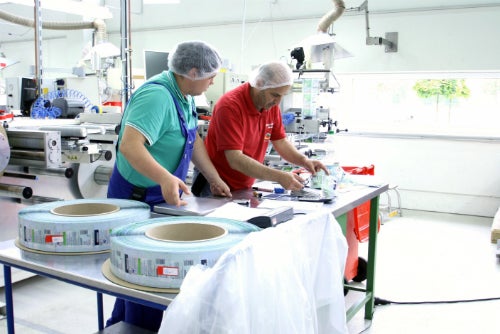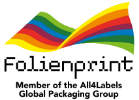
Ask Doris Erhardt-Freitag about Folienprint’s most innovative product, and she’ll point to a bright cardboard box containing vividly printed, individually packaged tea bags. "Each individual sachet is a unique specimen," the managing director explains.
With its Gallin-based factory, the company manufactures foil packaging for the food industry. It has offered digital printing in the flexible packaging sector since March 2015, meaning smaller or medium-sized quantities can now also be manufactured with high printing quality, expensive printing plates and long lead times are a thing of the past.
In the case of the tea sachets, a total of 30,000 bags have been printed, and mosaic software means each one is unique. Doris Erhardt-Freitag is confident this offers completely new potential for creativity in brand development and customer loyalty: personalisations, competitions, seasonal or promotional items, testimonial loyalty, all these projects are now easier to carry out with print-on-demand. She also thinks further ahead, adding that customers could use VR codes to receive further information or additional product recipe tips via an app.
Folienprint works closely with machinery manufacturers, suppliers and customers when developing new technologies.
"As a RAKO Group company, we are one of the first in the industry to have installed a beta testing system as early as 2014", explains Martin Lücke, digital printing project manager. The company needed an extra room for this ‘new account" – its printing cube, which was built into one of the halls in gleaming white. Only there can it guarantee the air humidity of 50% to 70 % and temperature of 22°C to 25°C, which the device needs to function optimally.
Sustainability: in the form of StarSaver®, the company has joined forces with Milupa to develop a resource-friendly alternative to the expensive, energy-intensive aluminium in packaging for powdered contents such as milk powder or food additives, an important step towards sustainable packaging, along with carbon-neutral production and foils from renewable raw materials.
"Development focused on preserving the same barrier properties as aluminium composite foils", Doris Erhardt-Freitag explains.
Folienprint has access to a total of 400 materials in its production processes. "A minimally modified foil component can completely change the properties", says a fascinated Martin Lücke, adding that the main aim is always to protect the food. As such, they prevent contamination or damage caused by machinery.
Packaging also keeps out harmful environmental elements such as light, oxygen and moisture, limiting spoilage resulting from microorganisms, loss of flavour or vitamins, and external odours. From the perspective of producers and traders, packaging must be lightweight, firm, stable, easily stacked, and enable damage-free transportation, while consumers expect it to be easy to open and close.
New developments are imposing additional requirements, such as ready-made meals capable of being heated up directly in their packaging.
Approximately 80% of the products are presented in retail without any advertising, a fact applicable to some 10,000 products at a classic food market. Each product has on average three seconds to attract attention. And manufacturers know this: the stipulated food labelling means packaging is an important information source, as well as an advertising space and means of communicating with the consumer.
"In the battle for customers, companies invest a lot in package development," says Karsten Schröder from Innoform Coaching GbR, a consultancy and advanced-training firm in the field of foil packaging. Packaging is being elaborately designed, and the trend is towards more and more colours and variety in the products.
"It appeals to emotions, is the face of the product, and is a brand carrier," Schröder continues, adding that foil packaging is still relatively limited in terms of sophistication compared to folded boxes. But the expert does see a future here, believing stand-up pouches will become increasingly popular. The savings in resource use compared to glass bottles or cans, coupled with functionalities like legibility, re-sealability, easy handling and robustness during transportation, are just a few relevant keywords here.
Perhaps one day, packaging will even become a collector’s item, similar to a one-of-a-kind tea sachet. Martin Lücke would love that, because ‘many consumers have no idea of the effort put into packaging, which is simply thrown in the bin after use’.
Text and pictures: Manuela Kuhlmann.

